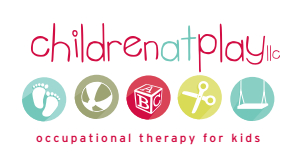The “Zones of Regulation” are used in classrooms, by occupational therapists, school counselors & more. They were developed by an OT, Leah M. Kuypers, MA Ed. OTR/L, and they are a visual & concrete approach for children to learn about feelings.
At Children At Play, we choose to use the Zones of Regulation as a teaching tool because:
The program is NEUTRAL and doesn’t project judgment of emotions→ No Zone is labeled as “good” or “bad.” Everyone has feelings, and that is OK!
Promotes a feelings-awareness including body cues, trigger awareness, and development of self-regulation, sensory strategies, and calming strategies.
Children will often encounter it in other places & the zone language is known by a lot of adults which will help the child’s communication be understood.
There are 4 Colored Zones for self-awareness and triggers for the different states of arousal:
1) Blue Zone: Describes a low state of alertness; sad, tired, sick. When one’s body/brain is moving slowly, and might need more rest breaks
2) Green Zone: Describes a regulated state of alertness, when one’s body feels “just right;” we are ready to listen and learn. Calm, happy, focused, proud, comfortable, relaxed. (This is the Zone we practice sensory/calming strategies in.)
3) Yellow Zone: Describes a heightened state of alertness, with slightly elevated emotions/states. We begin to feel like we could lose control of our bodies. Stress, frustrated, overwhelmed, worried/anxious, over-silliness, nervousness, wiggly, sensory seeking. This is the zone that we need to pick a strategy.
4) Red Zone: Describes extremely heightened states of alertness or very intense feelings. Out of control, angry, furious, upset. We might yell or throw toys, our heart beats fast, and our muscles get tight. We likely need an adult to help us calm down.
At our clinic, our occupational therapists implement & modify the program to be “the just right” fit making the presentation of information appropriate for different levels of learners. The information is always neuro-diversity affirming. We also like to add sensory components to feelings education for further integration and expansion of concepts. Feelings are felt and discussed while swinging, tactile play, sorting activities, and more.
The Zones of Regulation help children gain skills in the area of self-regulation. They said it wonderfully: “Self-regulation can go by many names, such as self-control, self-management, and impulse control. It is defined as the best state of alertness of both the body and emotions for a specific situation. For example, when a student plays on the playground or in a competitive game, it is beneficial to have a higher state of alertness. However, that same state would not be appropriate in the library. The lessons and learning activities are designed to help the students recognize when they are in the different Zones as well as learn how to use strategies to change or stay in the Zone they are in. In addition to addressing self-regulation, the students will gain an increased vocabulary of emotional terms, skills in reading other people’s facial expressions, perspective about how others see and react to their behavior, insight into events that trigger their behavior, calming and alerting strategies, and problem-solving skills.” - from the Zones of Regulation Website
Because colors are so effective at helping children understand feelings there are many common resources, many of which have slightly different color schemes. Red is always angry, Blue is usually sad, but after that, the colors are less consistent. Happy, calm, fear, love are all represented differently in different books, programs and resources. We always use Zones of Regulation, but if your child confuses the colors someone may have just read them the “Color Monster” or the “Crayon’s Book of Feelings.”
If you’d like to learn even more about the Zones of Regulation you can read their one-page explanation here, or check out the Zones of Regulation Website. To learn about the specifics for implementing the Zones of Regulation, click here to contact us.





